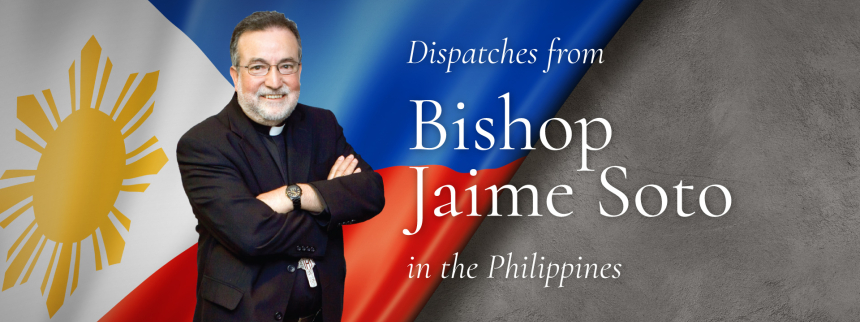
Our group left Manila last Wednesday morning to catch an early flight to Naga City on the Southeast end of the island of Luzon. Departing Manila, we leave behind the urban landscape dominated by the man-made forest of steel, concrete, and glass and entered a landscape where nature’s wonders push back on any human incursion. Towns emerge from the verdant forests or nestle next to lush, soaked rice fields. Rustic homes sit tucked among trees.
Maintaining a home in these fertile surroundings requires keeping nature at bay or learning to follow the rhythms of the fluid, resilient currents of land and sea. If not, the consequences were evident from the occasional abandoned homes, vehicles, boats littered and decaying as the vegetation covered them under a green web of boughs and branches.
We move from place to place on a bus. The roads are more than a means for transporting people and products. Along with the rivers and coasts that have always served as the locus for families to gather together, roads have also become the veins and arteries for social and economic exchange. As we would rumble through each small community, lining the street was a kaleidoscope of human stories in plain view: men at work, women busy with children and household chores, little tots playing in the puddles left by the day’s downpour, awkward young romances cuddled inside the covered sidecars of motorized tricycles, elderly men surveying the scenery with a cigarette in hand.
The road is an inseparable part of the families and neighbors whose front doors opened onto the highway upon which we were only a passing distraction. The roads crisscrossing under the lush green canopy of the islands are a vital social network integral to how neighbors understood their relationship to one another. The road was inseparable from their own sense of self. It was natural then that most of the roads would also lead to the church.
The Filipino people savor with delight their devotion to the Blessed Mother Mary. Indicative of their strong attachment to particular islands and regions of origin, they also hold a strong identification with the local manifestation of the Virgin Mother’s affection. With pride and a healthy dose of hyperbole they will claim their “Mother” or “Lady” is the most powerful or the most well-known. I diplomatically agreed with any such claim made to our group.
We have visited two such places so far: The Basilica of our Lady of Peñafrancia in Naga City, and the Shrine of Our Lady of Salvation outside of Legazpi City. It was a privilege and a joy to offer Mass in both places.
The popular devotion to the Blessed Mother at both places was very palpable. Surrounding these shrines was a network of businesses and services linked to the religious sites, borrowing the names, the images or both. Local pride and hopes for some economic good fortune find a common hope in the powerful heavenly advocate.
Both images reflect the legacy of the Christian evangelization that accompanied the expansion of the Spanish colonial empire. The name for Our Lady of Peñafrancia was probably a corruption of the name of the region from which the statue and its devotion originated, “la Peña de Francia”, “the hills of France”, most likely referring to the region around the Pyrenees mountain range separating the Iberian Peninsula from France and the rest of Europe.
Our Lady of Salvation is a more curious image of the Virgin Mary. She holds the child Jesus in one arm and with the other lifts a wayward sinner from the clutches of the devil lying below her feet. The local pastor explained to the pilgrims and me some of the early controversies surrounding this image. Some theologians feared that the image made Mary the savior and minimizing the role of Jesus. Others insisted that Mary’s intercession is available to sinners because both she as well as the sinner are part of the one body of Christ. That Mary extends her hand to the wayward soul is only possible because she embraces her Savior Son with her other arm.
Saturday’s reading from the first letter of John gives weight to the latter position: “We have this confidence in God, that if we ask anything according to his will, he hears us. And if we know that he hears us in regard to whatever we ask, we know that what we have asked him for is ours. If anyone sees his brother sinning, if the sin is not deadly, he should pray to God and he will give him life.” (I Jn. 5.14-21)
These affectionate images acknowledge that closeness many Filipinos feel for “Mama” María. The image from Legazpi, Our Lady of Salvation, esteems the Blessed Mother's abiding maternal support. She also serves to remind us of the bond we have with one another as her children and members of the One Body of Christ. We should lift up each other in prayer, helping one another to avoid evil and do all the good God enables us to do.
Bishop Jaime Soto is currently on pilgrimage in the Philippines with a group of clergy and laity from the Diocese of Sacramento. Stay tuned to our News page for more of Bishop Soto's reflections from this pilgrimage.
Read more: First Dispatch - Second Dispatch - Third Dispatch - Fourth Dispatch - Fifth Dispatch

